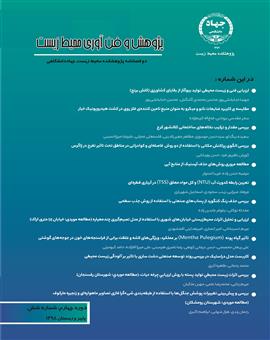Environmental Impact Assessment and Analysis of Urban Streets Using Multi-criteria Decision Making Model (Case Study: Arak 58 Meter Street)
Subject Areas :maryam hosseinkhani 1 , amir ansari 2 , amir Hedayati Agmashhadi 3
1 -
2 -
3 -
Keywords: Impact assessment Multi-criteria model, Fuzzy TOPSIS method, PASTAKIA method, ANP method,
Abstract :
Abstract Environmental impacts assessment, is a facility to ensure the proper implementation of a project and we can use it as a method in order to confirm, predict and explicate the impacts of a recommended project on the environment. The purpose of this research is to assess and plan the urban streets of Arak city in order to assert the air pollution reduction. Environmental impacts were assessed by using these three method: Multi-criteria like rapid matrix, ANP and fuzzy TOPSIS and both of them are decision-making method the process that has been followed in this study includes, introducing the selections, determining indices, (using library studies), Specify geographic area, observing environment basic condition and predicting and indicating impacts, assessing the impacts and providing commentary. In the following the status of environmental factors was examined. Due to this research, by checklist, the most important factors that might be affected by 58 meters street construction were found out and were selected as the criteria for assessing the effects. Then by using methods like rapid matrix, fuzzy TOPSIS and ANP, assessing the impacts of environment was separately fulfilled. In the rapid Matrix method, because of the more negative impacts relatively to positive impacts the project implementation has been used negatively. In both fuzzy TOPSIS and ANP methods the non-execution option have the most weight and preference. But among these the ANP method because of the ability to create a network with al matul connections between options and criteria at different levels and directions is selected as a suitable method for assessing the environment impacts in different project.
امینی، اژدروهمکاران. «ارائه مدل چندمعیاره برای ارزیابی اثرات محیط زیست جادههای آسفالت (مطالعه موردی: کمربندی شرقی همدان)، مهندسی حملونقل، تابستان 1393، شماره 4
آستانی، سجاد، حسام پور، مریم و طالب زاده، فاطمه، «کاربرد روش های تصمیم گیری چندمعیاره در محیط زیست»، اولین همایش ملی حفاظت و برنامه ریزی محیط زیست، بهار 1391- دانشگاه آزاد اسلامی واحد همدان- ایران
جمعه پور، محمود. "کتاب برنامه ریزی محیطی و پایداری شهری و منطقه ای (اصول، روش ها و شاخص های محیطی پایدار سرزمین).شماره 6.سازمان مطالعه وتدوین کتب علوم انسانی دانشگاهها(سمت)؛ خرداد1398، 420
حسینی مهدی و همکاران. «ارزیابی تأثیرات زیست محیطی گسترش بیرویه شهرها (مطالعه موردی:پروژه مسکن مهر-شهرطرقبه). فصلنامه برنامه ریزی منطقهای،تابستان 1394، شماره 18
دلنواز محمد و خالصی جلیل. «استفاده از روشهای کدگذاری و ماتریس لئوپولدجهت ارزیابی اثرات زیست محیطی احداث بزرگراه طبقاتی شهیدصدرتهران». نشریه مهندسی عمران و محیطزیست، پاییز1395، شماره84
رمضان زاده، حبیب الله ، مولائی، علیرضا و محمدمولائی، علی. «حملونقل شهری اثرات و راهکارهای زیست محیطی آن».اولین کنفرانس ملی شهرسازی، مدیریت شهری و توسعه پایدار، 1391، تهران- موسسه ایرانیان- انجمن معماری ایران
شهرداری اراک. «تهیه الگوهای حجمی و ضوابط احداث بنا و بدنه سازی خیابان 55 متری». شهرسازی، معماری و گردشگری پایدار، 1392
فلاحتکار، سامره وهمکاران.« ارزیابی اثرات زیست محیطی احداث آزادراه قمیشلو با استفاده از روش ماتریس LCOID و چک لیست». آمایش سرزمین، بهاروتابستان1389، شماره 2، دوره 2
فنی، زهره و مولودی جمشید.« ارزیابی محیط زیست شهری در قالب قوانین و ضوابط با تأکید بر آلودگی هوا». دو فصلنامه مدیریت شهری، پاییز و زمستان 1388، شماره 24، دوره 7
کوپاهی، مجید.« نقش الگوهای شبیه سازی در ارزیابی اثرات زیست محیطی طرح های عمرانی». محیط شناسی، 1366، شماره 2، دوره2
کیوانی، ناصر. «ضوابط استانداردهای زیست محیطی در زمینه محیط انسانی».دایره سبز؛1383، 158
محمدی ده چشمه، مصطفی و همکاران. «ارزیابی شاخصهای ناپایداری زیست محیطی در کلانشهر اهواز». محیط شناسی، تابستان 1394، شماره 2، دوره 41
مخدوم، مجید. «الگوی ارزیابی تغییرات محیط زیست». محیط شناسی، تابستان1361، شماره11، دوره11
مظلوم، بی بی زهرا و میکائیلی، علیرضا.« روش های ارزیابی اثرات محیطزیستی (مزایا و معایب). دومین کنفرانس برنامه ریزی و مدیریت محیط زیست، 1391-دانشگاه تهران- ایران
Banar, M, Kose ,B M, Ozkan A and Acar, I P (2007). Choosing a municipal landfill site by analytic network process. Environ
Geol journal, 52: 747– 751 Chen ,C.T and Huang ,S.F (2006). A fuzzy aroach for sulier evaluation and selection Application of Taiwan machinery firms.
International journal of uncertainty, fuzziness and kwledge-based systems, 13(2): 225-240 Jensen ,A and Laursen, k (1998). Use of the Rapid Impact Assessment Method (RIAM) on the fly ash landfill at the power
station Vestkraft I/S in Esbjerg. Danish Environmental Protection Agency,23: 49 Khan, Sh and Faisal, M N (2008). An analytic network process model for municipal solid waste disposal options. Waste
Management journal, 23: 11-98
Pastakia, C (1998). The Rapid Impact Assessment Matrix (RIAM)- A New Tool for Environmental Patil, S.K and Kant, R (2014). A fuzzy AHP-Topsis framework for ranking the solutions of knowledge management adoption
in supply chain to overcome is barriers, Expert systems with Applications, 41(2): 679-693 Sutciiffel, L (2009). Development of a framework for assessing sustainability in new product development. International
conference on engineering disign. Stanford university USA Wolfslehner, B, Vacik, H and Lexer ,MJ (2005). Application of the analytic network process in multicriteria analysis of
sustainable forest management. Forest Ecology and Management, 207: 157–170 Zebardast, L (2004). The Assessment of Anzali watershed change using remote sensing and management approaches. MS
Thesis. Tehran University, 124


